A Comprehensive Guide to Raw Crystal Names and Properties
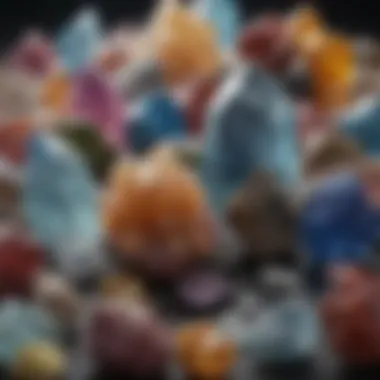
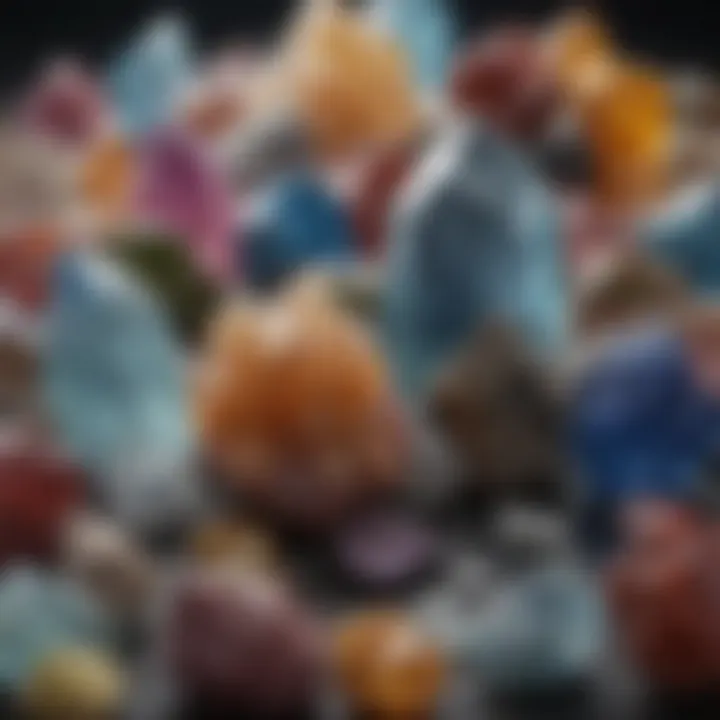
Intro
The world of raw crystals holds a fascinating allure, attracting enthusiasts and collectors alike. Each crystal tells a story through its unique name, properties, and origins. From ancient lore to modern metaphysical practices, these natural wonders have captivated our attention, fueling both scientific inquiry and spiritual exploration. Understanding the significance of these raw crystals transcends mere aesthetics; it requires a dive into their geological makeup and the cultural narratives intertwined throughout history.
As we unpack the names of these crystals, we will traverse through their journey from formation deep within the Earth to their role in contemporary life. With a focus on practical identification, care tips, and relevant cultural context, we aim to cultivate a deeper appreciation for these geological marvels. The ensuing sections will elucidate key points that not only shine a light on the scientific aspects but also touch on the metaphysical properties enticing many.
Next, we’ll turn the spotlight on our featured collectible of the month, unfolding the captivating attributes of a particular raw crystal that stands out this month.
Featured Collectible of the Month
Overview
This month, we delve into the enchanting Amethyst – renowned for its deep purple hues and long-standing reputation as a protective stone. With origins that can be traced back thousands of years, Amethyst has seen myriad uses across cultures, from being a symbol of royalty to a tool for meditation and healing. Its beautiful crystalline structures not only appeal to collectors' eyes but also invoke curiosity about its various forms and significance.
Historical Significance
Amethyst has transcended its geological origins to find a place in the hearts and lives of many throughout history. The ancient Greeks revered it, believing it provided clarity of mind and acted as a safeguard against intoxication. Similarly, during the Middle Ages, it was worn by clergy to symbolize humility and piety. Today, its allure continues as more people uncover its benefits in a spiritual context.
According to research from britannica.com, specialized geological formations are often responsible for the striking colors observed in Amethyst. Thus, understanding its origins not only enriches our appreciation but is also critical for those looking to identify genuine specimens. As we continue, we'll explore various techniques for identifying raw crystals, making it easier for both novice and seasoned collectors to navigate through the vast field of natural specimens.
Identification Techniques
Visual Characteristics
When it comes to identifying raw crystals, visual characteristics serve as the first line of defense against misidentification. Amethyst, for example, is typically found in clusters or geodes, often radiating a rich lavender to deep purple color. Look for:
- Color: Deep purple is desirable, though lighter shades exist.
- Clarity: Check for transparency; impurities can hint at lower quality.
- Shape: Understand the common formations, like pointy terminations or smooth surfaces.
Resources for Identification
Expert advice can be invaluable for enthusiasts eager to enhance their collection. Many resources can facilitate the identification process, including:
- Online forums like reddit.com, where collectors share pictures and insights.
- Reference books detailing crystal properties and visuals.
- Community groups on facebook.com, connecting collectors for shared expertise.
Utilizing these resources can vastly improve one's knowledge and confidence in selecting and identifying raw crystals. This understanding is not merely academic; it wraps itself into the very essence of collecting and respecting these natural treasures.
"In crystal collecting, knowing the name and origin may elevate your collection from ordinary to extraordinary."
As we progress through this article, deeper explorations of individual crystals will highlight their unique narratives while enhancing collector knowledge for future endeavors. This tapestry of geological mastery and cultural richness offers something for everyone, whether you're just starting or looking to deepen your appreciation.
Prologue to Raw Crystals
The intricate world of raw crystals invites enthusiasts and collectors alike to delve into its rich tapestry, revealing layers of geological history and metaphysical significance. Understanding raw crystals is more than a hobby; it’s a journey into nature’s artistry, where each stone carries its unique narrative and essence. This article endeavors to uncover the multifaceted aspects of raw crystals, focusing on their diverse names, which serve as gateways to appreciating their unique characteristics and histories.
Understanding Raw Crystals
Raw crystals—essentially unrefined mineral specimens—are formations resulting from natural geological processes. These stones exist in their purest state, untouched by human hands, and each one embodies a wealth of information about its formation, structure, and origins. For collectors, recognizing raw crystals goes beyond mere aesthetics; it’s about grasping the stories they tell. A piece of quartz might just seem like an ordinary stone to an untrained eye, but a collector sees the countless years of tectonic activity that shaped it, turning that rock into a relic of earth’s history.
There’s something palpably different about holding a raw crystal, feeling its weight, and noticing the nuances in its texture. Unlike polished counterparts, raw crystals maintain their natural flaws and features, which can tell you all kinds of things—where they've been, the elements they've encountered, and the conditions under which they formed. This connection draws collectors in, creating a bond that’s both intellectual and emotional.
The Importance of Crystal Names
The names assigned to raw crystals are not mere labels; they are intrinsic to the narratives and identities of these minerals. A crystal’s name can evoke the culture from which it emerged, reflect its physical properties, or even point to its place of origin. For instance, the name "amethyst" is derived from the Greek word "amethystos," which means "not intoxicated," indicating its historical use in warding off drunkenness.
"Understanding the name of a crystal is akin to understanding its soul."
Moreover, names foster a sense of community among collectors. They serve as a shared vocabulary, allowing enthusiasts to connect over specific types, properties, and uses of crystals.
For rock and fossil collectors, becoming familiar with the names of raw crystals enhances not only their appreciation of these wonders but also their ability to communicate within the community. It’s about bridging gaps – from geological terrains to personal experiences – and creating a sense of belonging in a vast and varied world of crystallography. In short, understanding and naming are intertwined, enriching both knowledge and connection among those who cherish these natural gemstones.
Categories of Raw Crystals
Understanding the different categories of raw crystals is crucial for enthusiasts and collectors alike. Each category showcases unique features and qualities that can enrich both the geological knowledge and the metaphysical experience one may have with these stones. By classifying raw crystals into distinct groups, it becomes easier to appreciate their rarity, beauty, and the science behind their formations. Doing so enables individuals to make informed decisions about their collection strategies as well as to grasp the significance and the stories behind each type.
Minerals
Minerals form the backbone of raw crystal collections. These are naturally occurring inorganic substances with a defined chemical composition and crystal structure. Minerals like quartz and amethyst are common finds in this category, exhibiting a vast range of colors and properties.

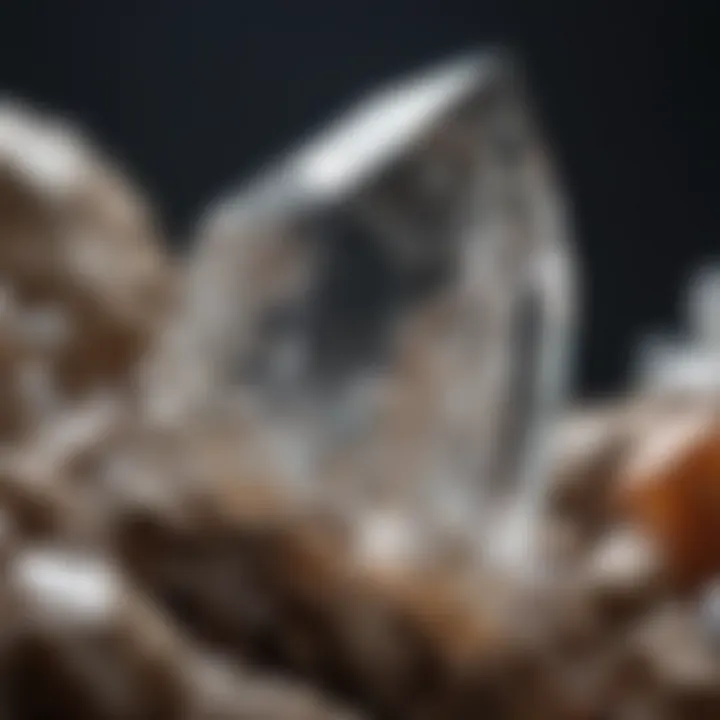
- Physical Characteristics: Minerals are often categorized based on their hardness, luster, and specific gravity. Take quartz, for example; it is fairly durable with a Mohs hardness of seven, making it an excellent choice for those starting a collection.
- Geological Significance: The formation of minerals involves complex geological processes, often occurring over millions of years in varied environmental conditions.
- Collecting Value: Minerals can be appreciated not only for their aesthetic appeal but also for their scientific value, often serving as indicators of the earth's history. Therefore, knowing how to identify and classify them is vital for any serious collector.
Gems
Gems are, without a doubt, the crown jewels of the raw crystal category. They are typically valued for their beauty and rarity. While all gems are technically minerals, they possess characteristics that elevate them to a different category altogether. Themes of luxury, exclusivity, and status surround gemstones like sapphire or emerald.
- Aesthetic Appeal: Gems are often cut and polished to enhance their brilliance and color, making them favorable in both jewelry making and decorative arts.
- Symbolic Associations: Many cultures attribute various metaphysical properties to these gems, believing them to possess powers that can influence emotions or promote healing.
- Investment Potential: Collectors might seek gems not only for their beauty but also for potential value appreciation over time, making them a dual-faceted investment.
Metaphysical Crystals
Metaphysical crystals extend beyond mere aesthetics or geological classifications. They are steeped in personal significance and spiritual journeys. Many collectors are drawn to these crystals for their purported healing energies and transformative properties.
- Healing Properties: Crystals like rose quartz and black tourmaline are often sought after for their believed ability to enhance emotional health and provide protection against negativity. Such claims, while subjective, attract a dedicated following.
- Cultural Rituals: Various cultures have long recognized the significance of these crystals. For instance, ancient Egyptians used lapis lazuli in their burial artifacts, symbolizing truth and wisdom.
- Practical Usage: Beyond decoration, collectors often incorporate metaphysical crystals into daily practices such as meditation, energy work, or personal rituals, adding another layer of depth to their collecting experience.
"The allure of raw crystals lies in their ability to connect us with the natural world and our personal journeys."
By diving into the categories of raw crystals, the collector not only enhances their knowledge base but also deepens their appreciation for the wide spectrum of options available. Whether it's minerals, gems, or metaphysical crystals, each category offers unique insights and experiences.
List of Common Raw Crystals
When it comes to raw crystals, their names carry more than just an identifier. They are the keys to understanding their intrinsic value, unique properties, and the roles they play in both natural and human contexts. This section dives into the importance of familiarizing oneself with these common raw crystal names, as it instills a sense of appreciation for the rich tapestry of Earth’s geological history and cultural significance.
Recognizing raw crystals improves identification skills, which can enhance collecting experiences and bolster one’s ability to engage in informed discussions about geology and metaphysics. Additionally, understanding these names equips collectors with insights that inform purchasing decisions, elucidating trends in availability and prices.
"In the world of raw crystals, knowledge of names is akin to a treasure map, guiding collectors toward hidden gems beneath layers of earth and time."
Amethyst
Amethyst is arguably one of the most recognized crystals, known for its striking purple hue. Believed to promote serenity and calmness, its popularity stretches back to ancient civilizations, including the Greeks, who viewed it as a protective stone against intoxication. Geologically, amethyst is a variety of quartz and derives its color from iron impurities, giving it a unique vibrancy. The balance between its beauty and metaphysical attributes makes it a staple for both collectors and those seeking its purported healing properties.
Quartz
Quartz, a cornerstone of mineralogy, is ubiquitous across the globe and showcases an amazing range of shapes and colors. Known as the "master healer," quartz is frequently used in various practices, from crystal healing to technology. Its ability to interact with light means it has fascinating optical characteristics, such as birefringence. Collectors are attracted not only to its diversity but also to the potential it holds as a conduit of energy within different metaphysical systems. The variations, from clear quartz to smoky or rose quartz, all add layers of intrigue and value.
Lapis Lazuli
Lapis lazuli is not just a pretty stone with its deep azure color; it has deep roots in ancient cultures, often adorning the tombs of pharaohs. This stone typically contains varying amounts of calcite and pyrite, giving it a distinctive appearance. Its historical significance is accentuated by its long-standing use in jewelry and ornamentation. Collectors often seek out high-quality specimens due to their rarity and the rich history attached. Moreover, with its associations with wisdom and truth, lapis lazuli draws in those who appreciate both beauty and meaningfulness.
Obsidian
Obsidian is essentially nature’s glass, formed from rapidly cooled volcanic lava. Its shiny black surface reflects light and creates stunning visual effects, making it a favorite among collectors. Historically, obsidian was utilized for cutting tools and decorative objects. Metaphysically, it's viewed as a powerful protector against negativity. Its raw, untamed qualities resonate with those who appreciate the primal force of nature and can often steer collectors' connections to the gemstone world toward a more instinctive understanding of their favored materials.
Citrine
Citrine, often referred to as the "merchant's stone," is prized not only for its sunny yellow hues but also for its alleged ability to promote prosperity and success. Formed from heat-treated amethyst or through natural processes, its vibrancy brightens any collection. Metaphysically, many people turn to citrine for boosting self-confidence and creativity. Its warm color serves as a bridge to the sun's energy, offering warmth both visually and spiritually. This aspect alone makes citrine a popular choice among those interested in not just collecting, but also personal empowerment and growth.
Understanding these common raw crystals encompasses more than mere names. They each tell a story that interweaves geology with human history, desire, and belief. This section serves as a gateway for collectors to appreciate not just what they hold in their hands, but the profound meanings that each crystal embodies.
Properties of Selected Raw Crystals
The study of raw crystals goes far beyond mere names and pretty appearances. Understanding the properties of selected raw crystals sheds light on their origins, uses, and how they can be appreciated or utilized by various enthusiasts and collectors. Physical traits, chemical makeup, and optical phenomena not only define each crystal but also impact how they are valued and interpreted in different contexts, whether geological or metaphysical. This section aims to dissect these properties, providing clarity on what makes each crystal unique and significant.
Physical Properties
Physical properties lay the foundation for identifying and categorizing raw crystals. These attributes include hardness, luster, and specific gravity, all crucial for collectors and mineralogists. For instance, consider the Mohs hardness scale, which ranks minerals from talc (the softest) to diamond (the hardest). Knowing the hardness of a crystal helps collectors understand its durability and practicality for various uses.
Key Physical Properties:
- Hardness: A measurement determining a crystal's resistance to scratching. Amethyst has a Mohs hardness of 7, making it suitable for everyday wear, while softer crystals like selenite (hardness of 2) require careful handling.
- Luster: Describes how light interacts with a crystal's surface. Crystals can exhibit different types of luster, such as metallic, glassy, or pearly. For example, quartz is known for its glassy luster, making it visually striking in any collection.
- Cleavage and Fracture: Refers to how crystals break. Some, like Kyanite, exhibit perfect cleavage, while others like obsidian show conchoidal fracture. Understanding these aspects can help collectors appreciate the natural formation of crystals.
Chemical Composition
Chemical composition is where the story of a crystal truly unfolds. Each raw crystal is made up of different elements which dictate not just its appearance but also its properties. For instance, quartz is primarily composed of silicon dioxide (SiO₂), whereas lapis lazuli contains a complex mix of lazurite, calcite, and pyrite.
Important Points on Chemical Composition:
- Elemental Make-Up: The fundamental minerals that comprise a crystal reveal its classification and potential usage. For instance, the presence of iron in hematite gives the crystal its characteristic red hue.
- Stability and Reactions: Some crystals are chemically stable, while others can be reactive under certain conditions. For example, calcite reacts with acids, helping geologists to identify it easily in the field.
- Trace Elements: The presence of trace elements can change a crystal's color or properties. For instance, trace amounts of chromium can turn a standard quartz crystal into a vibrant rose quartz.
Optical Characteristics
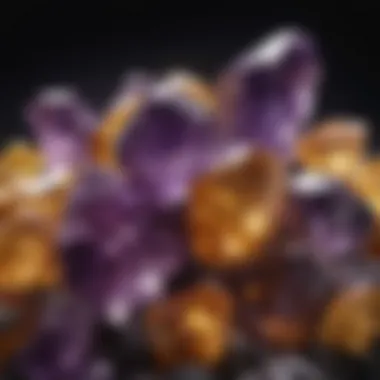
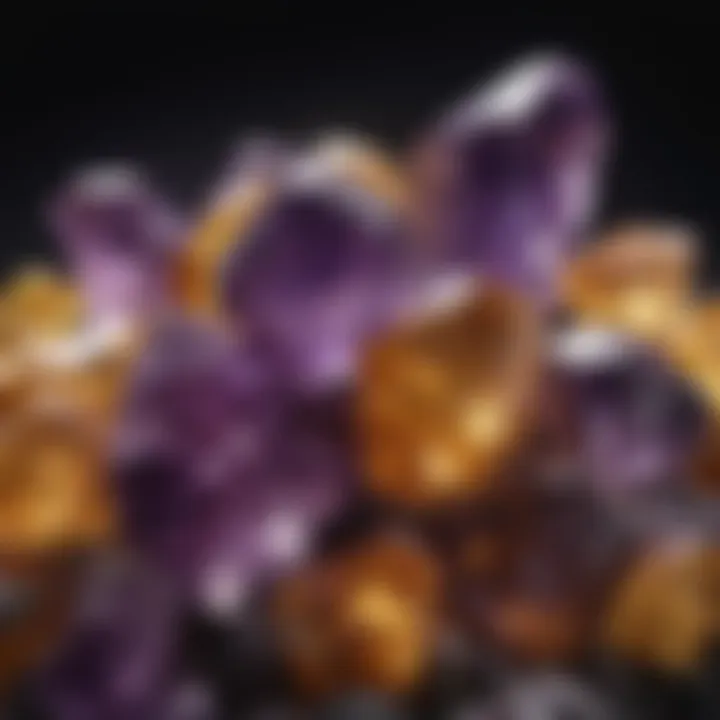
Optical characteristics play a crucial role in appeal and identification. Properties like birefringence, pleochroism, and fluorescence can mark a crystal from ordinary to extraordinary. Collectors often seek unique optical features, enhancing the allure and value of the specimen.
Notable Optical Features:
- Birefringence: The property where a crystal displays two different refractive indices. This is notably seen in calcite, intensifying its uniqueness and mystery.
- Pleochroism: This phenomenon allows some crystals to show different colors when viewed from different angles. An excellent example is tourmaline, which can appear green, blue, or even pink, depending on its orientation.
- Fluorescence: Some minerals glow under ultraviolet light. For example, fluorite can exhibit stunning colors like green and blue, making it particularly desirable for collectors.
Understanding these properties is not just an academic pursuit; it empowers collectors to make informed choices, enhances appreciation, and nurtures a deeper connection with the natural world.
The intricate dance between physical characteristics, chemical compositions, and optical phenomena makes each raw crystal a unique treasure. Recognizing these factors allows collectors to not only catalogue but truly appreciate their finds.
Geological Formation of Crystals
Understanding how crystals form is crucial for anyone interested in raw crystals. The geological formation of crystals is not just a topic that speaks to the science behind these beautiful formations; it lays the groundwork for comprehending their unique properties and potentials. Crystals, with their intricate structures and varying compositions, are a testament to the conditions in which they formed. Knowing these conditions can help collectors appreciate what they have, making it more than just a hobby.
Crystallization Processes
Crystallization is the process through which crystals form, often from a liquid or gas. It involves a series of steps that depend significantly on temperature, pressure, and the composition of the surrounding environment. Here are some key points to consider:
- Nucleation: The very first step in crystal formation. This is where atoms or molecules come together to form a stable cluster that will grow into a crystal. Nucleation can happen spontaneously in supersaturated solutions where the concentration of solute exceeds its solubility.
- Crystal Growth: Following nucleation is the actual growth of the crystal. It can be influenced by temperature fluctuations, the presence of impurities, and the rate at which the solution cools or evaporates. Different conditions can lead to different growth patterns.
- Types of Crystallization: There are two main types — primary and secondary. Primary crystallization occurs directly from a saturated solution or melt, while secondary crystallization may happen as a result of the reaction of the surrounding environment.
The mesmerizing shapes of crystals are largely the result of their growth processes. For example, quartz often forms hexagonal shapes while calcite might create rhombohedral formations. These unique characteristics are not just for show but also provide insight into the crystal’s origin, allowing collectors to authenticate their specimens.
Environmental Conditions
Environmental factors play a pivotal role in the formation of crystals. The conditions under which they evolve can vary widely, leading to the diverse range of crystals available to collectors today.
- Temperature: One of the critical factors affecting crystal growth. Higher temperatures can lead to faster crystal growth and larger sizes, while lower temperatures might result in smaller or more intricate formations.
- Pressure: This is particularly relevant for crystals formed deep within the Earth. High-pressure conditions can lead to the formation of unique minerals such as diamonds, which would not form under standard conditions.
- Presence of Solvents: The type and concentration of solvents can affect what kinds of crystals will form. For instance, salt crystals often form from evaporating seawater, while gypsum can form in conditions where calcium sulfate is present.
- pH Levels: The acidity or alkalinity of the environment can influence the solubility of various minerals, leading to different formations. For collectors, understanding the environmental conditions can also help in identifying and authenticating specimens.
"Each crystal tells a story of its formation—knowing the conditions allows you to connect more with your collection."
As a collector or an enthusiast of raw crystals, diving into the geological formation not only broadens your knowledge but also enhances your appreciation for each piece you encounter. The interplay of these elements is a reminder of the intricate dance between geology and aesthetics that crystals represent.
Cultural and Historical Significance of Crystals
The role of crystals is not just grounded in their physical properties; their cultural and historical significance stretches back to the dawn of human civilization. Throughout the ages, crystals have been attributed with mystical properties and have served as symbols deeply woven into the tapestry of various cultures. From ancient to modern times, these shimmering stones have played integral roles in rituals, medicine, art, and even trade.
Crystals in Ancient Civilizations
In ancient societies, crystals were more than beautiful stones; they were often considered as protection, guidance, and sources of power. For instance, the Egyptians harnessed the energy of gemstones, using them in not just jewelry but also in amulets that they believed warded off evil. Lapis Lazuli, a deep blue stone, was highly cherished and used for ornamental purposes but also believed to help the wearer connect with the divine. In China, jade was regarded not only for its beauty but as a representation of purity and moral integrity. Its significance went so far that it was commonly used in burials, ensuring that the deceased transitioned safely into the next life.
This connection to the spiritual realm can also be seen in the traditions of Native American tribes, where quartz crystals are employed in ceremonies intended for healing or to initiate higher states of consciousness. The ancient Greeks and Romans had their own beliefs too, associating amethyst with sobriety and self-control. They carved the stone into drinking vessels, reinforcing the idea that it could prevent drunkenness while showcasing the beauty of the gem itself.
Modern Interpretations and Usage
In contemporary times, the allure of crystals has only grown, fueled by ongoing interest in holistic healing and metaphysical practices. Many modern practitioners of spirituality often utilize raw stones for meditation, energy healing, and manifestation. Clear quartz, often dubbed the “master healer,” is a favored choice among both novice and experienced crystal users. It’s believed to amplify energy and thought, making it a versatile tool in various healing practices.
Furthermore, the market for crystals has taken on a vibrant life of its own, with collectors and enthusiasts actively seeking out unique pieces for both aesthetic and practical uses. Crystals are not only used as decor in homes, lending a natural and tranquil touch, but they also inspire various DIY projects, from crystal-infused candles to handmade jewelry.
"Crystals have the ability to connect us to the universe, allowing us to harness the energies that resonate within and around us."
The fascination with these geological wonders doesn't stop at individual use; they have even made their mark in popular culture and social media. Platforms like Instagram and Pinterest are awash with images of beautifully arranged crystals, often accompanied by personal stories or therapeutic experiences. These platforms allow both collectors and casual enthusiasts to share knowledge, experiences, and tips about specific stones, thus fostering a communityication around the beauty and significance of crystals today.
Finale
In summary, the cultural and historical significance of crystals is vast and varied, presenting a narrative that weaves through time. From serving as protective talismans in ancient civilizations to modern healing tools and aesthetic delights, the evolution of crystals reveals much about humanity’s relationship with nature, energy, and spirituality. As interest continues to blossom, raw crystals remain a bridge between the earthly and the ethereal, offering insights, beauty, and connection to all who seek them.
Identifying Raw Crystals
Identifying raw crystals is an essential skill for rock and fossil collectors, enthusiasts, and anyone with an interest in geology. Knowing how to distinguish one crystal from another not only enriches the collector's experience but also provides insights into the properties and origins of these fascinating natural formations. With a plethora of varieties, each boasting unique colors, forms, and features, the ability to identify crystals accurately can significantly enhance one's appreciation for their beauty and significance.
Being adept at identification helps collectors make informed decisions about their acquisitions. This knowledge can save time and prevent costly mistakes, such as purchasing a look-alike or mislabelled piece. Moreover, understanding the nuances of crystal identification can heighten one’s knowledge of geology and mineralogy, connecting enthusiasts more deeply with the natural world.
Visual Observation Techniques
When it comes to identifying raw crystals, visual observation is the first line of defense. This method entails looking at various physical attributes, like color, translucency, and clarity, to form an initial assessment. Here are some key aspects to consider:
- Color: The hue can be a major identifier. For instance, a vivid blue might suggest lapis lazuli, whereas milky white might indicate quartz.
- Clarity: Is the crystal clear, translucent, or opaque? Clarity can often lead to clues about the mineral composition.
- Crystal Structure: Many crystals have unique shapes or patterns. Familiarizing oneself with common forms can be quite helpful. For example, the hexagonal shape of quartz is a distinct identifier.
- Luster: This refers to how light interacts with the surface. It can range from shiny to dull and affects the visual appeal.


It's beneficial to combine visual observations with a good magnifier. Bringing a loupe can help spot tiny inclusions or defects that provide more definitive clues.
Physical Tests for Identification
Once visual assessments are made, physical tests can provide a more concrete identification. Here, collectors can resort to practical tests that help discern specific properties:
- Hardness Test: This entails using the Mohs scale of hardness to see how the crystal resists scratches. For instance, if a crystal can scratch glass, it's likely harder than 5.5 on the scale.
- Streak Test: Rubbing the crystal against a porcelain plate can reveal its true color in powdered form; this might differ from its appearance as a whole piece.
- Acid Test: Certain minerals react to hydrochloric acid. For example, calcite fizzes or bubbles when acid is applied. However, make sure to carry out this test carefully.
- Cleavage and Fracture: Observing how a crystal breaks can give insights into its structure. Some cleave perfectly along certain planes while others might shatter irregularly. This can be a major identifier, as some minerals have distinctive cleavage patterns.
Mastering these techniques elevates your ability to identify raw crystals effectively.
"The art of identification extends beyond mere recognition; it is the gateway to understanding the intricate stories these natural formations have to tell."
By blending visual techniques with physical testing, collectors can gain a well-rounded perspective, ultimately leading to a deeper appreciation of their specimens.
Caring for Raw Crystals
Caring for raw crystals is an essential aspect of maintaining their beauty and integrity. These natural wonders are not just aesthetically pleasing; they hold both geological and metaphysical significance. Proper care can enhance the life and vibrancy of these stones, allowing collectors and enthusiasts to enjoy their full potential. This section explores key cleaning methods and storage recommendations, ensuring your collection remains stunning and spiritually resonant.
Cleaning Methods
Keeping your raw crystals clean is vital for both aesthetic and energetic reasons. Dust and dirt can obscure their natural beauty, while grime can interfere with their energetic properties. Here are some effective cleaning methods:
- Water Rinse: For most stones, a gentle rinse under lukewarm water is sufficient. This method is simple, yet effective in removing surface dust.Note: Some minerals, like selenite, should not be submerged in water due to their solubility.
- Saltwater Soak: Dissolving salt in water to soak your crystals can cleanse them of residual energy. Just remember to rinse afterward to remove salt residue.
- Smudging with Sage: Burning sage and passing your crystals through the smoke is an age-old technique to cleanse them of negativity. This method is especially popular for crystals used in healing.
- Use of Clear Quartz: Placing raw crystals in a bowl with clear quartz can amplify their cleansing properties. The clear quartz acts as a purifier, absorbing any negative energies.
- Ultrasonic Cleaners: For crystal enthusiasts looking for a high-tech cleaning option, ultrasonic cleaners are capable of deep-cleaning without scratching. However, it’s best to check compatibility with your specific crystal type before proceeding.
Remember: Always research the specific characteristics of each crystal to determine the best cleaning method. Crystals like obsidian or malachite may require gentler approaches to uphold their natural structure.
Storage Recommendations
Once your crystals are clean, storing them properly is just as crucial. Improper storage can lead to scratches, damage, and even energetic disruptions. Here are some recommendations for storing your raw crystals:
- Use Soft Cloth Pouches: Placing your crystals in soft pouches will help prevent scratches and absorb any errant moisture.
- Display Cases: Consider using a display case to both showcase and protect your crystals. Glass-fronted cases can offer both visibility and protection from dust.
- Separate Storage: Avoid stacking different types of crystals together. Some crystals can scratch more delicate stones or even produce unwanted energetic exchanges.
- Avoid Direct Sunlight: While some crystals like citrine and amethyst can handle light, prolonged exposure might fade their colors over time. Store them in a cool, dark place to maintain vibrancy.
- Organize by Type or Purpose: Grouping your crystals by type or intended use (decorative, metaphysical healing, etc.) can simplify selection when you need them. This also adds an organized touch to your collection.
Caring for raw crystals doesn't just protect their beauty; it enhances their value as items of interest for collectors and enthusiasts alike. With these cleaning methods and storage tips, your raw crystals can shine in their full splendor for years to come.
Collecting Raw Crystals
Collecting raw crystals is like piecing together a captivating story about the Earth. Each stone has its own narrative — shaped by time, natural processes, and cultural significance. Crystal collecting is not just a hobby, it's a way to connect with nature and appreciate the unique beauty found within the very rocks beneath our feet. It offers both aesthetic pleasure and the thrill of exploration. As collectors venture into quarries, riverbeds, or markets, they are not merely searching for beautiful stones; they seek to unlock nature's hidden treasures and to learn about their geological origins.
The process comes with its own set of considerations and benefits. Aside from offering a stunning display on a shelf, raw crystals can also contribute to personal growth and well-being. With each crystal believed to harbor different properties, collectors often form a bond that transcends mere ownership. This connection can usher in a greater understanding of how these natural objects influence daily life and decision-making. Here are some specific elements to consider:
- Diversity of Types: The variety is staggering. From quartz to lapis lazuli, understanding the differences can help inform a collection that is both visually appealing and scientifically enlightening.
- Local vs. Global: Some collectors prefer to focus on local specimens, fostering a connection to their immediate environment, while others pursue rare finds from around the world.
- Cultural Significance: Many stones carry historical narratives, deeply entwined with the cultures that revere them, enriching the collecting experience.
Strategies for Starting a Collection
Starting a collection can feel daunting, but with the right approach, it becomes an enjoyable journey. First, define what draws you to crystals — is it their beauty, the science, or perhaps metaphysical properties? Consider the following steps:
- Research: Understand the different types of crystals and what interests you most. Books, online articles, and forums can be invaluable resources.
- Visit Mineral Shows: Events like rock and mineral shows are treasure troves. These fairs allow collectors to interact with sellers and fellow enthusiasts, fostering a sense of community.
- Establish a Budget: Decide how much you are willing to spend. Crystals can vary greatly in price, so being realistic helps prevent overspending.
- Start Small: Begin with a few foundational pieces. Rather than overwhelming yourself with dozens of stones, picking a select few empowers you to learn more about each one.
- Documentation: Maintain a collection journal. Recording details, such as where and when you found each stone, can enhance the personalization of your collection.
Ethical Considerations in Collecting
Ethics plays a crucial role in ensuring that the enjoyment derived from collecting raw crystals does not come at the expense of the environment or ethical treatment of others. Here are key considerations to keep in mind:
- Responsible Sourcing: Seek out sellers who prioritize sustainable and ethical practices. When buying, inquire about the origins of the crystals and any extraction methods used to obtain them.
- Legal Regulations: Be aware of local laws regarding mineral collection. Some areas may prohibit collection without permissions or have protected specimens.
- Respect for Nature: Only collect what you can use and always leave environments better than you found them. Scrambling through areas carelessly can damage fragile ecosystems.
- Cultural Sensitivity: Acknowledge cultures that consider certain stones sacred. Collecting these can be seen as disrespectful or exploitative.
Collecting is more than mere acquisition; it is also about stewardship — for nature, for cultures, and for fellow enthusiasts.
By harnessing the thrill of discovery while navigating the ethical landscape, collectors can enjoy their passion while being mindful of the world around them. This approach not only enriches personal experience but also contributes to a sustainable practice in the long run.
End
The conclusion serves as a critical juncture in this exploration of raw crystal names. It is where the myriad threads woven throughout the article come together, offering readers a clearer perspective on the significance and practicality of understanding these natural wonders. A well-rounded conclusion does not merely restate what has been discussed but emphasizes the essential learnings and insights that can be carried forward.
Recap of Key Learnings
As we wrap up, it’s essential to highlight some crucial learnings from our journey:
- Diversity of Crystals: The article has shown that raw crystals are not just visually stunning but also vary significantly in physical and chemical properties. Each type—from Amethyst to Obsidian—holds its distinct features.
- Cultural Relevance: Crystals have held meaning in various cultures throughout history. From ancient civilizations adorning their temples with these minerals to modern collectors who see them as more than mere objects, the cultural narratives surrounding these stones are abundant and captivating.
- Care and Collection: Knowing how to care for, clean, and store crystals ensures their longevity and preserves their beauty. Collectors must also be reminded of the ethical considerations entailed in acquiring these specimens.
"Understanding the broader context of raw crystals enriches the experience of collection. It transforms a hobby into a deep appreciation for nature's artistry."
Future Perspectives on Raw Crystals
Looking ahead, the future of raw crystals seems promising, especially as interest in sustainable practices grows. Collectors and enthusiasts are increasingly turning to ethically sourced crystals, which not only ensures their acquisition is responsible but also fosters a deeper connection with the natural world.
Moreover, as scientific research delves into the metaphysical and geological aspects of these crystals, new findings could reveal even more about their potential benefits. From enhancing personal well-being to their applications in technology, the exploration of raw crystal names may just be in its infancy. As the world acknowledges the gifts of our Earth, crystal enthusiasts will undoubtedly contribute to a dialogue that blends appreciation for natural history with a mindful approach toward preservation and collection.



